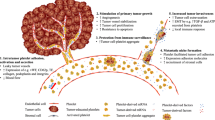Abstract
Annexins are a large group of calcium-dependent cytoskeletal- and membrane-associated proteins whose properties include cytoskeleton and phospholipid binding and mitotic signal transduction. Although annexin-like molecules have been reported on the external plasma membranes of certain cells, in general they are considered to be cytoplasmic proteins. We report here the heterogenous expression of certain annexins (I-VI) on the external cell surfaces of non-metastatic and metastatic murine (RAW117 large-cell lymphoma), rat (13762NF mammary adenocarcinoma) and some human (KM12 and HT29 colorectal carcinoma) cell lines but not on some other cell lines such as human (A375 and McWo) and mouse (B16) melanoma. The implication of annexin cell surface expression in the metastatic process is discussed with respect to tumor cell adhesion.
Similar content being viewed by others
References
Ewing J, A Treatise on Tumors, 3rd edn. Philadelphia: W. B. Saunders, 1928.
Nicolson GL, 1988, Tumor cell and host organ properties important in colonization of specific secondary sites.Biochimica et Biophysica Acta,948, 175–224.
Nicolson GL, 1991, Molecular mechanisms of cancer metastasis: tumor and host properties and the role of oncogenes and suppressor genes.Current Opinion in Oncology,3, 75–92.
Nicolson GL. Tumor cell adhesion-and growth properties and organ-specific metastasis. In: Zetter BR, ed.Homing Mechanisms and -Cellular Targeting. New York: Marcel Dekker Publishers, in press, 1992.
Zetter BR, 1990, The cellular basis of site-specific tumor metastasis.New England Journal of Medicine,322, 605–612.
Tressler R and Nicolson GL, 1992, Butanolextractable and detergent-solubilized cell surface components from murine large cell lymphoma cells associated with adhesion to organ microvessel endothelial cells.Journal of Cellular Biochemistry,148, 162–171.
Tressler RJ, Updyke TV, Yeatman TJ and Nicolson GL, 1992, Extracellular annexin 11 is associated with divalent cation-dependent tumor cell-endothelial cell adhesion of liver-metastatic large-cell lymphoma cells.Proceedings of the National Academy of Sciences, U. S. A.
Burgoyne RD and Geisow MJ, 1989, The annexins are a family of calcium-binding proteins.Cell Calcium,10, 1–10.
Brunson KW and Nicolson GL, 1978, Selection and biologic properties of malignant variants of a murine lymphsarcoma.Journal of the National Cancer Institute,61, 1499–1503.
Morikawa K, Walker SM, Nakajima M, Pathak S, Jessup JM and Fidler IJ, 1988, Influence of organ environment on the growth, selection, and metastasis of human colon carcinoma cells in nude mice.Cancer Research,48, 6863–6871.
Giavazzi R, Jessup JM, Campbell DE, Walker SM and Fidler IJ, 1986, Experimental nude mouse model of human colorectal cancer liver metastases.Journal of the National Cancer Institute,77, 1303–1308.
Matsushita Y, Hoff SD, Nudelman ED, Otaka M, Hakomori S, Ota DM, Cleary KR and Irimura, 1991, Metastatic behavior and cell surface properties of HT-29 human colon carcinoma variant cells selected for their differential expression of sialyldimeric LE antigen.Clinical and Experimental Metastasis,9, 283–299.
Updyke TV and Nicolson GL, 1986, Malignant melanoma cell lines selectedin vitro for increased homotypic adhesion properties have increased ex perimental metastatic potential.Clinical and Experimental Metastasis,4, 273–284.
Fidler IJ, 1973, Selection of successive tumor lines for metastasis.Nature 242, 148–149.
Kozlowski JM, Hart IR, Fidler IJ and Hana N, 1984, A human melanoma line heterogenous with respect to metastatic capacity in athymic nude mice.Journal of the National Cancer Institute,72, 913–917.
Neri A, Welch D, Kawaguchi T and Nicolson GL, 1992, Development and biologic properties of malignant cell sublines and clones of spontaneously me tastasizing rat mammary adenocarcinoma.Journal of the National Cancer Institute,68, 507–517.
Cailleau R, Olive M and Cruciger QVJ, 1978, Long term human breast carcinoma cell lines of metastatic origin: preliminary characterization.In Vitro,14, 911–915.
Kaetzel MA and Dedman JR, 1989, Affinity-purified site-directed antibody recognizes the entire annexin protein family.Biochemical and Biophysical Research Communications,160, 1233–1237.
Kaetzel MA, Hazarika P and Dedman JR, 1989, Differential tissue expression of three 35-kDa annexin calcium-dependent phospholipid-binding proteins.Journal of Biological Chemistry,264, 14463–14470.
Mathew JK, Krolak JM and Dedman JR, 1986, Calcimedins: purification and characterization from chicken gizzard and rat and bovine livers.Journal of Cellular Biochemistry,32, 223–234.
Updyke TV and Nicolson GL, 1986, Immunoaffinity isolation of membrane antigens with biotinylated monoclonal antibodies and streptavidin-agarose.Methods in Enzymology,121, 717–725.
Blackwood RA and Ernst JD, 1990, Characterization of Ca2+-dependent phospholipid binding, vesicle aggregation and membrane fusion by annexins.Biochemical Journal,266, 195–200.
Zaks WJ and Creutz CE, 1990, Evaluation of the annexins as potential mediators of membrane fusion in exocytosis.Journal of Bioenergetics and Biomembranes,22, 97–120.
Schlaepfer DD and Haigler HT, 1990, Expression of annexins as a function of cellular growth state.Journal of Cell Biology,111, 229–238.
Wirl G and Schwartz-Albiez R, 1990, Collagen-binding proteins of mammary epithelial cells are related to Ca2+-phospholipid-binding annexins.Journal of Cellular Physiology,144, 511–522.
Brisson A, Mosser G and Huber R, 1991, Structure of soluble and membrane-bound human annexin.Journal of Molecular Biology,220, 199–203.
Author information
Authors and Affiliations
Rights and permissions
About this article
Cite this article
Yeatman, T.J., Updyke, T.V., Kaetzel, M.A. et al. Expression of annexins on the surfaces of non-metastatic and metastatic human and rodent tumor cells. Clin Exp Metast 11, 37–44 (1993). https://doi.org/10.1007/BF00880064
Received:
Accepted:
Issue Date:
DOI: https://doi.org/10.1007/BF00880064




